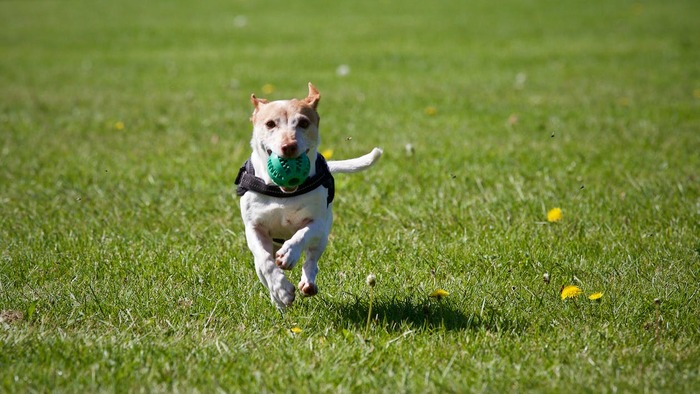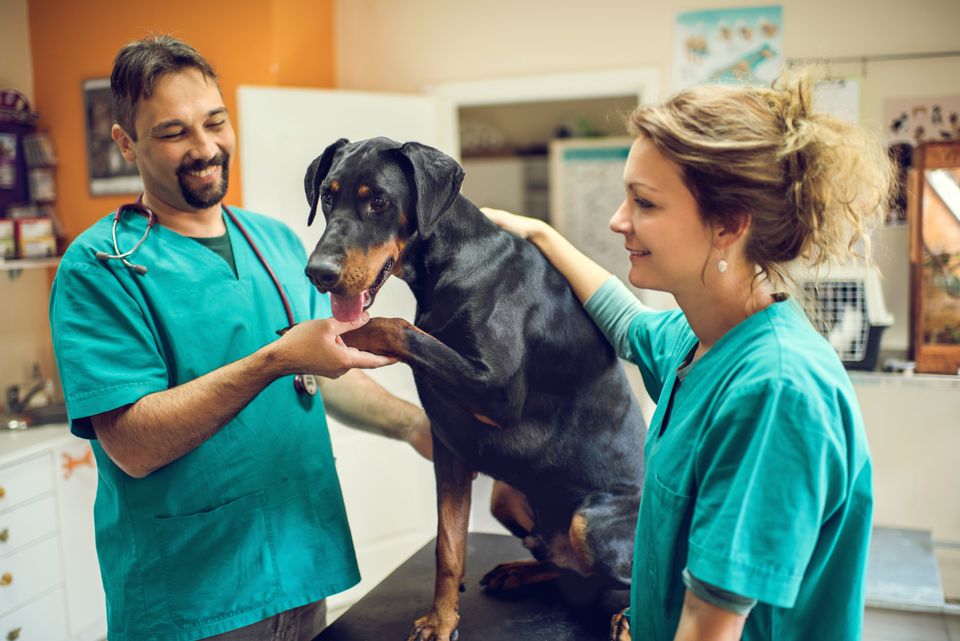- What Are Service Dogs?
- What Are Psychiatric Service Dogs?
- Psychiatric Service Dogs vs Emotional Support Animals
- Who Qualifies for a Psychiatric Service Dog?
- What Dogs Do Qualify for Psychiatric Service Dogs?
- Psychiatric Service Dog Certification & Registry
- Psychiatric Service Dog Training
- Owner Trained vs Professionally Trained Service Dogs
- Psychiatric Service Dog Tasks
- Psychiatric Service Dog Identification

The use of Psychiatric Service Dogs increased in the last years as they proved an effective type of “medical equipment” for people with various mental disabilities. Many people worldwide dealing with the so-called “invisible disabilities” greatly benefit from the tasks that these incredible dogs perform.
We want to pay special attention to psychiatric service animals, including training, certification, registration, and regulations. This article is likely to give you answers to essential questions in regard to the nature of psychiatric service dogs and help you gain a better idea of what to expect if you decide to have a psychiatric service dog.
What Are Service Dogs?
Service dogs are dogs who have been individually trained to perform specific tasks for the benefit of a person with a disability, both physical and mental. These tasks must be directly related to that disability. Service dogs can be dogs only. Some U.S. states also accept miniature horses as service animals.
What Are Psychiatric Service Dogs?
Psychiatric service dogs are a type of service animal, that have been individually trained to do work / perform tasks to mitigate the symptoms of mental disabilities, including but not limited to anxiety, depression, PTSD, and bipolar disorder.
Psychiatric Service Dogs vs Emotional Support Animals
Since there is still some confusion when it comes to animals who provide mental support, it is essential to differentiate those two terms. As explained above, psychiatric service dogs must perform specific tasks that benefit a person with a disability. Emotional support animals, on the other hand, provide comfort through their presence and companionship. They do not go through specialized training to be trained to do specific work. Unlike psychiatric service dogs, emotional support animals may be excluded from public premises, that run a “no-pet” policy. Also, ESAs are no longer allowed to fly in the passenger cabin free of charge. Another important difference between the two types of animals is that ESAs are not limited to dogs and can be all kinds of domesticated species, including cats, guinea pigs, birds, rabbits...etc.
However, there are also similarities between the two types of animals, namely that both of them provide mental support and that they assist one person only. Also, both types of animals are protected under the Fair Housing Act and reasonable accommodation must be provided to them.
|
|
Emotional Support Animals | Psychiatric Service Dogs |
| Can be all types of domesticated species |
✔
|
x
|
| Can be dogs only |
x
|
✔
|
| Perform specific tasks |
x
|
✔
|
| Go through specialized training |
x
|
✔
|
| Have public access rights |
x
|
✔
|
| Are protected under the Fair Housing Act |
✔
|
✔
|
| Are allowed to fly in the passenger cabin free of charge |
x
|
✔
|
| Support one person |
✔
|
✔
|
Who Qualifies for a Psychiatric Service Dog?
The eligibility criteria for obtaining a psychiatric service dog (PSD) are designed to ensure that individuals with diagnosed mental and emotional disabilities receive the necessary support. Qualification for a PSD is based on specific factors, including the nature of the disability and the tasks the dog can perform to alleviate its symptoms. Here's an overview of who qualifies for a psychiatric service dog:
1. Diagnosed Mental or Emotional Disability: To be eligible for a PSD, an individual must have a diagnosed mental or emotional disability recognized by a licensed mental health professional. This may include conditions such as depression, anxiety disorders, PTSD, bipolar disorder, OCD, and more.
2. Task-Based Assistance: The key distinction between an emotional support animal (ESA) and a PSD is the ability to perform specific tasks that mitigate the symptoms of the disability. A PSD must be trained to carry out tasks that help the individual cope with or overcome their disability. These tasks could include providing tactile stimulation during panic attacks, reminding the handler to take medication, interrupting self-harming behaviors, or creating a physical barrier in crowded spaces.
3. Professional Recommendation: A licensed mental health professional, such as a psychiatrist, psychologist, or therapist, must provide a recommendation or prescription for a PSD. This recommendation should outline the individual's diagnosis, the tasks the dog is trained to perform, and how those tasks relate to managing the disability.
4. Functional Impact: The diagnosed disability must substantially limit the individual's ability to perform major life activities, such as interacting with others, working, concentrating, or sleeping. The PSD's tasks should directly address these limitations and enhance the person's quality of life.
5. Individualized Training: A PSD requires specialized training to perform tasks directly related to the handler's disability. The training process should be tailored to the individual's needs and can be conducted by a professional trainer or the handler themselves, with the guidance of a trainer.
6. Public Access Skills: In addition to task training, a PSD must also undergo public access training to ensure proper behavior in various environments. This includes being well-mannered in public spaces, following commands, and remaining focused on the handler's needs.
What Dogs Do Qualify for Psychiatric Service Dogs?
It is very important to note, that unless a country did not prohibit a certain dog breed, service dogs, including psychiatric service dogs, may not be excluded based on assumptions about the animal’s behavior. All types of dog breeds can be trained as service animals. What is important is, that the animal is healthy and has the right temperament for the job. Puppy testing is usually conducted to identify whether a dog has the potential to become a service dog or not. A pup must be calm, friendly, people-oriented, and curious about its surroundings, but not overly emotional, or too shy and anxious. It should tolerate physical contact and must not show signs of aggression. All service animals must be up-to-date with all vaccinations and have a healthy and neat appearance.
Psychiatric Service Dog Certification & Registry
We have reached a “hot topic” so to say, as the intention of many service dog handlers/users is to register and certify their service animals, in order to make them “legitimate”. There is no official service dog registry, nor is there a website, that is affiliated with a government agency, or offers this type of service. A service dog can be registered with a certain website only, which means that information about a service dog team will be available on this particular website’s database. Registering a service animal may be helpful as additional notification to the public about the nature of the dog, namely that he/she is a service dog and not just a pet. However, it does not provide the dog or his/her handler with any rights.
When it comes to service animal certification, it is the same case in the US and the UK. Having a certificate means that a service dog has gone through specialized training and is able to perform specific tasks, that are directly related to a person’s disability.
However, based on the country where you live, you may need to get your service dog certified with a member of an internationally recognized organization like Assistance Dogs International (ADI) or International Guide Dog Federation (IGDF) or get him/her evaluated by an accredited local school.

Psychiatric Service Dog Training
Service dog training includes two parts:
• Basic obedience training;
• Specialized service dog training;
Each of these types of training is essential for a dog to properly “function” as a service animal.
Basic obedience training is necessary to verify that a dog is well-mannered and can behave him/herself in public settings. A service dog must be able to perform tasks such as “sit”, “stay”, “recall” (come when called), and calmly walk on a leash. Also, focus training is an essential part of basic obedience training. A dog must be able to stay focused on his/her handler despite his/her surroundings. Focus training guarantees, that a service dog will perform the trained tasks at any time, location and regardless of how crowded a place is or what sounds smells, or other distractions there are. Once a dog completes basic obedience training, he/she can move to more advanced training, which is specific and depends on the person’s needs.
Owner Trained vs Professionally Trained Service Dogs
Training a service dog, and a psychiatric service dog, in particular, is a crucial part of preparing them for their role. Generally, there are several options available for training a service animal:
-
Getting a trained service dog;
There are many organizations and trainers, who are specialized in different kinds of dog training-puppy training, basic obedience, service dog training for different types of tasks...etc. Some organizations train dogs to become service animals (it usually takes about 2 years) and then provide these to people who need a service animal. The costs for a fully trained service dog can reach up to $30.000-$40.000. Costs are so high, as dogs who will become service animals, have been carefully taken care of and properly trained during this time to be impeccable at their job as service animals. By “impeccable” we do not mean that a service animal can never make a mistake. Service animals are still living creatures, and we should be realistic in the way we perceive them. An advantage of this option is that the organization/school/trainer will have already done the most difficult part- a dog has been evaluated, potty-trained, and trained in basic obedience and specialized tasks. The disadvantage of this option, besides the high costs (which can be prohibitively high for many people), is that the service dog user has not been actively engaged in the process of raising and training the dog until the time comes for them to get the dog. There is no bond between a dog and a user and most importantly- the user will have to go through “training” themselves to learn how to interact with the dog. Let’s also not forget, that there are usually long waiting lists, especially if you want to get a service dog through a non-profit organization.
-
Training your dog with an organization / a school / a trainer;
A more advantageous option, based on the costs, which still includes in-person training, is having a dog and getting him/her trained with a school/organization/trainer. It will be costly, but not as much as the option above. Costs will also depend on the program you would like to enroll in, its duration, how reputable the organization is, your location (costs may vary on the location), the trainer’s schedule and qualifications...etc. However, this option gives you the opportunity to participate in group or individual classes and be actively engaged in the process of training. Disadvantages of this option are associated with costs (based on the program they can reach up to $1000-$2000, weekly, i.e. boarding schools), taking the risk of not getting enough attention when in group classes, and following an already set schedule of a trainer. Of course, this option gives you the opportunity to have a professional by your side, who will support you.
-
Owner/self-training a service dog (yourself only or through an owner/self-training program);
This option has become very popular, as it offers flexibility, it is the most affordable one, and you can spend valuable time with your dog and develop a strong bond with him/her. There is a lot of information available online, which can provide you with tips on how to conduct training. However, training a dog that way might not be very effective. There are owner/self-training programs, which include in-person training or are completely online. These types of programs typically include trainer support and provide well-structured lessons. The disadvantages of this option are associated with the time and effort you will need to invest. You should be really committed to the process and be very patient and persistent. Otherwise, it is not likely to work.
When opting for a program/school/organization or a trainer, you should do detailed research and get informed about the costs, how training works, how much you will need to be involved, what training approach will be used, what the training duration is...etc. You should make sure that the person/organization you will work with, is not only reputable and legitimate but also suit your needs and personality. Some programs/trainers can be loved by some people and totally disapproved by others. You should find what works for you.

Psychiatric Service Dog Tasks
Some of the most essential psychiatric service dog tasks are:
Deep Pressure Therapy, tactile stimulation (pawing, nose-nudging, giving a kiss), grounding the owner when they have an episode, interrupting harmful behaviors, using their body to protect the owner, providing panic control in public, guiding the owner to a safe place, retrieving objects (i.e. medication, phone, beverages), alerting for anxiety, reminding of medication, notifying family members or specific people when the owner has an episode...etc.
As you can see, there are many different tasks that the term “psychiatric service dog tasks” include. They all depend on the person and their needs.
Psychiatric Service Dog Identification
Just like service dog registration, service dog identification can be very beneficial while in public, as it notifies the public about the status of the dog, namely that he/she is currently on duty and is not just a pet. However, service dog identification itself does not guarantee any access rights and is not legally required. This is valid for the US and the UK. Based on your location, your service dog may need to have some sort of identification. You should check your local laws in regard to service animals.













